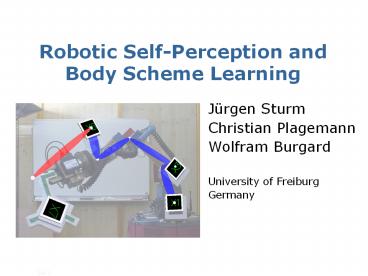Robotic Self-Perception and Body Scheme Learning - PowerPoint PPT Presentation
Title:
Robotic Self-Perception and Body Scheme Learning
Description:
Robotic Self-Perception and Body Scheme Learning J rgen Sturm Christian Plagemann Wolfram Burgard University of Freiburg Germany – PowerPoint PPT presentation
Number of Views:106
Avg rating:3.0/5.0
Title: Robotic Self-Perception and Body Scheme Learning
1
Robotic Self-Perception and Body Scheme Learning
- Jürgen Sturm
- Christian Plagemann
- Wolfram Burgard
- University of Freiburg
- Germany
2
Motivation
- Existing robot models are typically
- specified (geometrically) in advance
- calibrated manually
3
Motivation
- Problems with fixed robot models
- Wear-and-tear
- wheel diameter, air pressure
- Recovery from failure
- malfunctioning actuators
- Tool use
- extending the model
- Unknown model
- re-configurable robots
4
Motivation
- Problems with fixed robot models
- Wear-and-tear
- wheel diameter, air pressure
- Recovery from failure
- malfunctioning actuators
- Tool use
- extending the model
- Unknown model
- re-configurable robots
- Similar problems in humans/animals?
5
Motivation
- Problems with fixed robot models
- Wear-and-tear
- wheel diameter, air pressure
- Recovery from failure
- malfunctioning actuators
- Tool use
- extending the model
- Unknown model
- re-configurable robots
- Similar problems in humans/animals?
- growth, aging
- injured body parts
- writing
- riding a bike
6
Related Work
- Neuro-physiology
- Mirror neurons Rizzolatti et al., 1996
- Body Schemes Maravita and Iriki, 2004
- Robotics
- Self-calibration Roy and Thrun, 1999
- Cross-modal maps Yoshikawa et al., 2004
- Structure learning Dearden and Demiris, 2005
7
Problem motivation
- Fixed-model approaches fail when
- parameters change over time
- geometric model is not available
Our Contribution
- Bootstrapping of the body scheme and
- Life-long adaptation using visual
- self-observation
8
Problem Description
Think Bootstrap, monitor, and maintain internal
representation of body
Act Joint angles
Sense 6D Poses
9
Problem Formulation
- Visual self-perception of n body parts
- Actuators (m action signals)
- Learn the mapping
Configuration
Body pose
10
Existing Methods
- Analytic model parameter estimation
- Function approximation
- Nearest neighbor
- Neural networks
Requires prior knowledge
High-dimensional learning problem
Requires large training sets
11
Body Scheme Factorization
- Idea Factorize the model
We represent the kinematic chain as a Bayesian
network
12
Bootstrapping
- Learning the model from scratch consists of two
steps - Learning the local models (conditionaldensity
functions) - Finding the network/body structure
13
Learning the Local Models
- Using Gaussian process regression
- Learn 1D ? 6D transformation functionfor each
(action, marker, marker) triple
14
Finding the Network Structure
- Select the most likely network topology
- Corresponding to the minimum spanning tree
- Maximizing the data likelihood
15
Model Selection
16
Model Selection
- 7-DOF example
- Fully connected BN
17
Model Selection
7-DOF example Fully connected BN Selected
minimal spanning tree
18
Forward Kinematics
- Purpose
- prediction of end-effector pose in a given
configuration - Approach
- integrate over the kinematic
- chain in the Bayesian network
- by concatenating Gaussians
- approximate the result
- efficiently by one Gaussian
19
Inverse Kinematics
- Purpose Generate motor commands for reaching a
given target pose - Approach Estimate Jacobian of end-effector using
forward kinematics prediction - Use standard IK techniques
- Jacobian pseudo-inverse
20
Experiments
21
Evaluation Forward Kinematics
- Fast convergence (approx. 10-20 iterations)
- High accuracy (higher than direct perception)
22
Evaluation Inverse Kinematics
- Accurate control using bootstrapped body scheme
23
Life-long Adaptation
- Robots physical properties will change over time
- Predictive accuracy of body scheme needs to be
monitored continuously - Localize mismatches in the Bayesian network
- Re-learn parts of the network
24
Life-long Adaptation
- Initial
- Error is detected and is localized
- Robot re-learns some local models
25
Life-long Adaptation
26
Evaluation
- Quick localization of error
- Robust recovery
27
Summary
- Novel approach learning body schemes from scratch
using visual self-perception - Model learning using Gaussian process regression
- Model selection using data likelihood as
criterion - Efficient adaptation to changes in robot geometry
- Accurate prediction and control
28
Future Work
- Active self-exploration, optimal control, POMDPs
- Marker-less self-perception
- Moving robot
- Tool use

